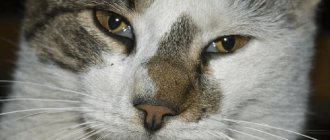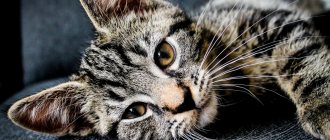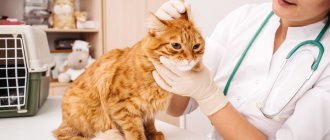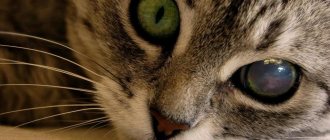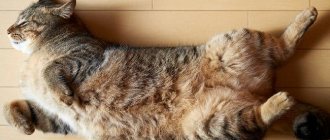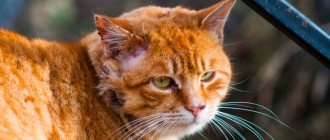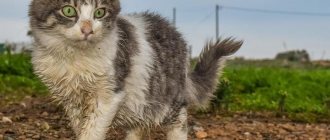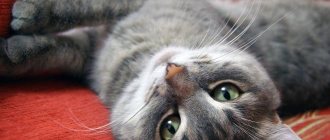Why does pathology develop?
The third eyelid is a fold of the conjunctiva located in the inner corner of the eye, which, in turn, consists of the nictitating membrane - a thin mucous membrane lining the surface of the eyeball and the inside of the eyelid. This membrane moisturizes the cornea with tear fluid and cleans it of debris.
We can say that it resembles a cleaning brush on car windows, performing a similar function. In addition, thanks to the lacrimal gland located at the base of the third eyelid, the cornea is reliably protected from pathogenic microorganisms.
If a cat has a slight covering of the eye with the third eyelid, there is no redness, inflammation, or swelling, then this does not always mean a problem with the eye. Perhaps the organ of vision is sunken due to a reduction in fat caused by weight loss, or the cat flu is developing in your pet.
The causes of third eyelid prolapse are varied. The most common of them include:
- Viral, fungal, bacterial infections.
- Pathologies of internal organs - kidneys, liver, gastrointestinal tract.
- Antibiotic therapy.
- Malfunction of the central nervous or hormonal systems.
- Inflammatory processes in the ears.
- Weak ligaments responsible for the activity of the eyelids.
- Consequence of head injuries.
- Worm infestation.
- A foreign body that has entered the eye and cannot be washed away by the tear fluid on its own.
- Any form of conjunctivitis.
- Adenoma (benign tumor of the third eyelid).
- Atrophy of the eyeball.
Prolapse of the third eyelid can be diagnosed in absolutely any pet, but representatives of the Persian cat breed are most susceptible to this pathology.
Causes
Prolapse of the third eyelid in a cat can occur for a variety of reasons. As we wrote above, sometimes it can become an indicator of harmful diseases or infections in the furry body. A kitten's third eyelid can be a genetic feature (especially common in Persian and British cats), an allergy, or a reaction to something getting into the eye. Let's figure it out.
1. Allergy (allergic conjunctivitis) A reaction can occur to anything. Thus, household chemicals, food, and pollen can cause a third eyelid to appear in a cat. Even a banal decrease in immunity can cause such a reaction. However, it is impossible to accurately determine the cause of the disease without the help of a veterinarian.
2. Infections and parasites Do not write off various types of infections, from viral to bacterial. Chlamydia, mycoplasmosis, etc. can cause inflammation of the cat's third eyelid. In addition, the cause of this disease can be parasites, whose larvae are often carried into the house on shoes or clothes from the street. Read about the main infections in cats: What are the types of infections in cats and how to treat them
3. Adenoma Another common disease is adenoma of the third eyelid in cats. This is a benign tumor caused by disruptions in the hormonal background of a cat (especially a thoroughbred like a Persian or Exotic), injuries or the same infections. The worst thing you can do if you discover an adenoma in your cat is to let the situation go and expect it to go away on its own. This disease is constantly evolving and can lead to other infections entering the cat’s body through it.
4. Diseases of internal organs Inflammation of the third eyelid in a cat can be a consequence of such serious diseases as renal failure, disturbances in the gastrointestinal tract, diarrhea, and so on. In this case, this same inflammation is also a kind of allergic reaction to substandard processes occurring in the body.
5. Eye injury One of the most common causes of third eyelid prolapse in cats. Your pet could have scratched this part of the eye on something; a speck or grain of sand could have gotten in there. However, the need to contact a veterinarian does not become less, since in any case surgical or medicinal intervention will be necessary.
6. Genetic predisposition Pedigree cats (like dogs) very often have a tendency to a certain type of disease. Thus, inflammation of the third eyelid is common among Persian and British breeds.
Symptoms
A condition is considered pathological when the third eyelid does not fold and almost completely covers the organ of vision. Experiencing discomfort, the four-legged furry dog begins to rub its face, blink frequently, squint and hide from the irritating light in a secluded place. His eyes turn red, tears flow from them, mucus and pus are released.
Subsequently, a voluminous dense formation is formed in the corners. The temperature often rises.
If one eye is covered with film, then most likely a foreign body has entered it. When there is drooping of the eyelid and narrowing of the pupil, they speak of a pathology of a neurological nature. But if changes are noticed in both eyes, then this is a serious systemic disease.
Often a visible third eyelid is the result of a fight or self-scratching and infection entering the wound. Infection leads to the formation of a creeping corneal ulcer or keratitis. The eye becomes cloudy, erosion appears on the surface with white or greenish discharge. This is a very dangerous condition that can be fatal.
Consequences of inflammation of the third eyelid in a cat
As we already wrote above, inflammation of the third eyelid in a kitten or adult cat is often not an independent phenomenon, but a consequence of more serious pathologies in the animal’s body. Thus, if not treated in a timely manner, other diseases can go unnoticed and lead to truly tragic consequences, including death. Moreover, if the disease of the internal organs is really serious and poses a danger to the furry one.
In case of an allergy, it will be necessary to get rid of the pathogen as soon as possible, because if your cat is still prone to such a reaction to allergens, further interaction with it will have an even more detrimental effect on the pet and will cause swelling in other parts of the body.
Adenoma requires surgical intervention, since its further development will contribute to the entry of harmful infections into the body.
Eye injury (mechanical) is no less dangerous for babies than adenoma, since both of them can lead to blindness of the eye on which the kitten’s third eyelid is inflamed. While they are not yet adult cats, their immunity is significantly weakened and is unable to fight such diseases on its own. Therefore, if inflammation is detected, you should immediately contact a specialist.
Fungal infections are also dangerous for cats and can lead to a variety of consequences: from hair loss to serious changes in the functioning of the animal’s organs.
Read more: What are fungal diseases in cats?
Diagnostic methods
Diagnosis is aimed at determining the etiology. To make a diagnosis, a comprehensive examination of the animal is carried out, including the following measures:
- taking anamnesis;
- visual inspection;
- general and biochemical blood tests;
- flushing from the mucous membranes of the eyes;
- ultrasonography;
- PCR diagnostics.
After identifying the cause of the pathological condition (third eyelid in a cat), the veterinarian prescribes appropriate treatment.
Video "Eye diseases"
The video will talk about what eye diseases can occur in cats.
Sorry, there are no surveys available at this time.
Was this article helpful?
Thank you for your opinion!
The article was useful. Please share the information with your friends.
Yes
No
X
Please write what is wrong and leave recommendations on the article
Cancel reply
Rate the benefit of the article: Rate the author ( 8 votes, average: 4.50 out of 5)
Discuss the article:
Treatment, prognosis
To eliminate infectious pathologies, therapy is practiced, which is based on antiviral and antifungal drugs. Their task is to suppress the development of pathogenic microorganisms.
The animal is also prescribed antipyretics, painkillers, and immunostimulants and vitamin-mineral complexes to strengthen the immune system.
If prolapse of the third eyelid is associated with an allergic reaction, then the allergen is eliminated and antihistamines are prescribed. For general improvement of the condition, hormonal agents are indicated (in advanced stages).
Eye injuries are treated by using anesthetic drops and rinsing to remove foreign bodies and debris. Surgery is performed only in severe cases.
If the prolapse of the third eyelid is caused by an adenoma, but the neoplasm does not grow and does not bother the animal, then removal of the benign tumor is not carried out. The operation may have unpleasant consequences, such as dry eye syndrome. As a rule, veterinarians limit themselves to supportive therapy.
Organ structure
As numerous photos show, the nictitating membrane on one side is adjacent to the cornea. On the other, to the upper and lower eyelids, to their inner surface.
The inner part of the membrane is covered with lymphoid tissue, which can be mistakenly mistaken for the focus of the inflammatory process of a disease such as, for example, follicular conjunctivitis. When it is removed, the protective function is weakened.
The eyelid maintains its shape thanks to cartilage. It emerges from the medial angle, while promoting the tightest possible fit of the membrane to the cornea. Its base is surrounded by tear-producing tissue. It is attached by soft ligaments to the periosteum of the skull.
Functioning of the membrane
The membrane functions involuntarily. The cat alone will not be able to make the transparent shell move. The eyelid begins to move forward when the head is lowered or during irritation of the cornea. The membrane slides smoothly over the cornea, disinfecting the surface with tear fluid.
Regardless of its functions, the eyelid can have some pathologies that will negatively affect the health of the cat.
Pathologies
There are some breeds of cats that can experience prolapse or protrusion of the nictitating membrane. This is most dangerous in the period from 2 to 9 months of life. Due to constant blinking, an enlarged eyelid can become injured.
Due to its large size, the membrane will come into contact with the cornea, creating discomfort for the pet. The situation will become more complicated if the fluffy starts rubbing his eyes on his own. The video will show you what complications associated with third eyelid prolapse look like.
What to do at home
The owner must strictly follow the veterinarian’s instructions and provide the pet with good living conditions, rest and adequate nutrition. It is recommended to reduce physical activity.
Under no circumstances should you self-medicate or use medications purchased without consulting a specialist.
Remember that if you try to insert a membrane yourself, you can cause irreparable harm to your vision.
During treatment, the cat must rinse its eyes. But for this you should not use the good old folk methods, such as strong tea, but special drugs that relieve inflammation.
A good result is obtained by the Beaphar Oftal eye wash, sold in a veterinary pharmacy. It does an excellent job of cleaning the eyes and fur around them from debris, stimulates self-cleaning and prevents the appearance of tear stains.
After washing the organ of vision, eye drops are used. Among those recommended by veterinarians are Actipol, Levomycetin, Floxal. These drugs are most effective for conjunctivitis and infections. The use of two drugs simultaneously enhances the therapeutic effect. As a rule, experts advise combining Floxal with Korneregel. The course is at least 14 days.
Drops are the most optimal form of the drug. Gel or ointment is much more difficult to apply. The drug is placed under the lower eyelid with the index finger (in no case directly from the tube!). To ensure that it is evenly distributed, the eye must be massaged. Immediately before the procedure, nails should be trimmed, otherwise the cat may be injured.
The pet will resist manipulation, so it needs to be secured with a blanket or thick towel.
Prevention
Prevention of inflammation of the third eyelid in cats is quite simple and largely coincides with methods of preventing any other diseases. Thus, “Murkosha” strongly recommends keeping your pets at home. Otherwise, the risks of infection through parasites and the appearance of pathologies of the skin and internal organs increase significantly.
Read more about the dangers of the street: Self-walking - when freedom means death
The next thing a cat owner should pay attention to is the pet’s diet and living conditions. Remember that they are living beings just like us, so cats also need to live in comfortable conditions with optimal temperature, cleanliness and humidity. Make sure that the food is suitable for your pet in terms of the ratio of vitamins and nutrients. In addition, you should not feed an adult cat with kitten food or a pregnant cat with food for sterilized individuals.
It is worth paying special attention to the treatment of furry animals from parasites, because they are the carriers of dangerous diseases and infections. And, of course, don’t forget about vaccinations! This is the most important aspect of protecting an animal from many diseases and infections, so “Murkosha” strongly recommends visiting veterinary clinics on time and not sparing money on quality medications. Remember that the health of your pet is entirely in your hands and its life depends only on your actions!
Functions of the eye membrane
The secretion secreted by the cartilage glands washes the cornea, providing lubrication to the moving eyelid. The membrane is large enough to completely cover the cornea.
It was not by chance that nature endowed ancient animals with an organ.
Predators (which include cats) were forced to hunt, making their way through forest thickets, fight with “competitors”, defending their prey, and therefore the eyes needed reliable protection
Domestic cats remain predators by nature, and the internal membrane continues to fulfill its “duties.”
| Name | Meaning |
| Protective | In combination with the outer eyelids, protects the eyes from damage |
| Cleansing | During the blinking process, it removes small particles that fall on the cornea |
| Moisturizing | Transports tear fluid across the cornea, preventing it from drying out |
| Immune | Lymphoid nodules produce immunoglubogulin secretion, which provides protection against infections |
The membrane comes into play when the cat's eyes close.
The fold, straightening, moves from the inner corner to the outer. On its way, it sweeps away all small debris and evenly distributes the tear over the entire surface of the eye.
Preventive measures
Cats with bulging eyes are more susceptible to hair loss. But representatives of other breeds should also be given no less attention to avoid problems.
Prevention includes:
periodic visits to the veterinarian for the purpose of timely detection of diseases;- regular deworming of your pet;
- compliance with vaccination schedules;
- treatment for ticks and fleas.
A balanced diet supports your pet's immune system. Limiting contact with stray animals helps avoid injury and infection.
Vestigial organ or not
The inner eyelid is also called blinking and is perceived by some as an atavism (similar to the appendix in humans). Almost all animals have this organ.
Having developed at the beginning of evolution, the eyelid still continues to perform its functions, so it cannot be called rudimentary. But a century ago, experts considered the organ useless and recommended its removal: supposedly, the film prevents the animal from seeing better.
Modern biologists do not agree with this statement.
They are sure that the cat’s inner eyelid is in demand and perfectly fulfills its purpose, i.e. is an active organ, not a rudiment.
